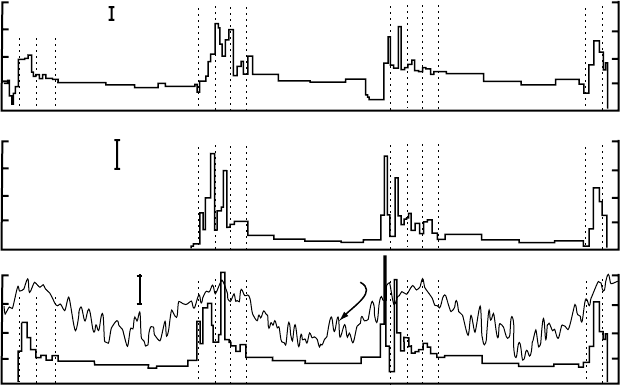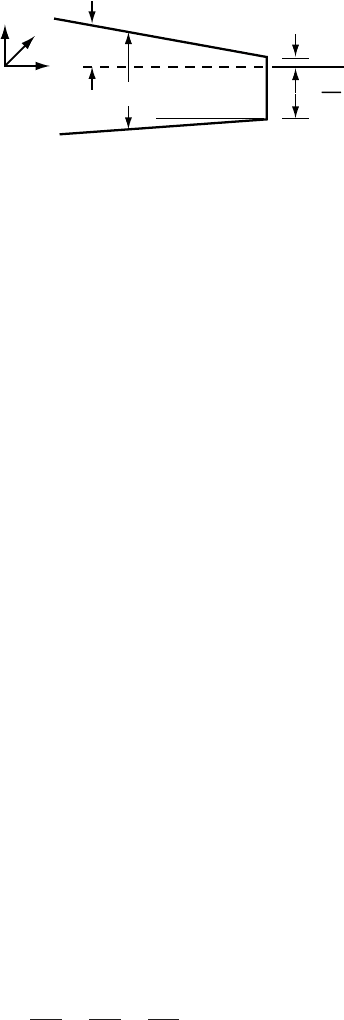Hooke R.L. Principles of glacier mechanics
Подождите немного. Документ загружается.


Calculating basal shear stresses 331
0 500 m
Contour intervals:
20 m surface, 40 m bed
0 100 mm d
−1
Scale for velocities
Stake
Velocity vector
N
A
Block used in force
balance calculation
Tarfala
station
(elev. 1130 m)
SD05
Strain
diamond
B
A
SD1.35
SD02
SD05
1500
1200
1360
1480
1220
Figure 12.9. Map of Storglaci
¨
aren showing generalized surface and bed
topography (solid and dashed contours, respectively), locations of stakes used for
velocity measurements, velocities, and blocks used in force balance calculations.
(Data from Hooke et al., 1989, Figure 1a. Base map courtesy of Peter Jansson.)

332 Applications of stress and deformation principles
June
July
Aug
June
July
Aug
July
Aug
June
60
20
SD 1.35
70
30
SD 05
June
July
Aug
June
July
Aug
July
Aug
June
60
20
SD 02
1982 1983 1984 1985
10
0
−10
−20
Temperature,
o
C
Horizontal speed, mm d
−1
Standard error
for surveys
7 d apart
Temperature
u
=
33.7 mm d
−1
u
=
36.8 mm d
−1
u
=
31.6 mm d
−1
Figure 12.10. Time series of mean horizontal velocities of the three strain
diamonds (SD) shown in Figure 12.9.Velocities are averages of those of the four
(or five) stakes in each diamond. Mean daily temperature, smoothed using a
five-day running mean, is shown in the bottom panel. (Modified from Hooke
et al., 1989, Figure 3a. Reproduced with permission of the International
Glaciological Society.)
Term 2 (the second term on the right in Equation (12.30)). From the
strain rate data, it can be seen that at the upglacier end of the block ˙ε
xx
became less compressive, and in two cases, even extending, while at
the downglacier end it became more compressive in all but one case.
Thus, the accelerations were not due to either push from upglacier or
pull from downglacier. The clear implication is that they were a result of
a reduction in resistive drag at the bed, presumably induced by increases
in water pressure.
In the case of block B, the strain rate data indicate that the marked
change in Term 2 reflects push from upglacier and, in the case of the
June 1984 event, pull from downglacier. This combination of push and
pull resulted in higher strain rates in the basal ice, and hence, owing to
the proportionality between stress and strain rate, in higher basal drag.
Because we assumed that strain rates are uniform over the sides and
ends of the blocks, and also owing to other uncertainties in the calcula-
tions, the values of τ
b
obtained are only estimates. However, as the errors
are probably of comparable magnitude and sign in all calculations, the
direction and approximate magnitude of the changes in τ
b
are proba-
bly reliable. These calculations thus help us understand the mechanisms

Creep of floating ice shelves 333
z
y
x
h
H
h
H
r
r
w
sea level
Figure 12.11. Coordinate
system used in discussion of
floating ice shelves.
by which the accelerations took place in these instances. Through such
analyses, we can gain insight into spatial and temporal variations in
factors controlling the velocity of a glacier.
Creep of floating ice shelves
Ice shelves around Antarctica play an important environmental role,
as they act as dams, restraining the flow of ice from the interior of
the continent. Were they to break up, ice levels in the interior would
decrease rapidly over a period of a few centuries, and sea level would
rise accordingly. Break up of ice shelves in northeastern North America
may have contributed to the collapse of the Laurentide Ice Sheet at the
end of the Wisconsinan. Thus, understanding the flow of ice shelves is
a problem of both academic and environmental significance.
The problem of ice shelf flow is unique because τ
b
is likely to be
quite low where the shelf is grounded, and goes to zero in the limiting
case when the shelf is afloat. Herein, we consider only the latter case.
Weertman (1957b)was the first modern glaciologist to study this prob-
lem, and our approach follows his initially, but then incorporates some
important modifications introduced by Thomas (1973a).
The coordinate system to be used is shown in Figure 12.11. The origin
is at sea level, but is within the ice mass. The z-axis is vertical and positive
upward. H is the thickness of the shelf, and h is the height of the surface
above sea level. Inland, the surface rises gradually and the base drops
further below sea level, so H and h both increase. As long as the ice shelf
does not become grounded, however, we assume that hydrostatic equi-
librium is maintained; therefore, assuming a constant density and thus
ignoring the low density snow and firn at the surface, (H − h)ρ
w
= Hρ
i
,
where ρ
w
and ρ
i
are the densities of water and ice, respectively.
At the risk of being repetitive, it is convenient, once again, to write
out the momentum balance equation in the z-direction:
∂σ
xz
∂x
+
∂σ
yz
∂y
+
∂σ
zz
∂z
+ ρ
i
g = 0 (12.31)
Our objective is to obtain an expression for σ
xx
, and then to use the flow
law to solve for ˙ε
xx
.

334 Applications of stress and deformation principles
Because shear stresses are zero at the bed and surface, it is reasonable
to assume that σ
xz
= σ
zx
= σ
yz
= σ
zy
= 0. This means that velocities and
strain rates are independent of z. Equation (12.31) can thus be integrated:
0
σ
zz
dσ
zz
=−ρ
i
g
h
z
dz
to yield:
σ
zz
= ρ
i
g(h − z) (12.32)
Thus, σ
zz
is simply the hydrostatic pressure at depth (h − z).
Suppose that field measurements at some point give:
˙ε
yy
= η˙ε
xx
and ˙ε
xy
= v˙ε
xx
(12.33)
Then, from the incompressibility condition:
˙ε
zz
=−(1 +η)˙ε
xx
(12.34)
Both η and ν are functions of horizontal position, but because strain rates
are independent of z, η and ν are also independent of z. Then because
we assume that ice is isotropic, we have ˙ε
ij
= λσ
ij
,where, as before,
λ = σ
n−1
/B
n
. Thus,
σ
yy
= ησ
xx
,σ
xy
= νσ
xx
, and σ
zz
=−(1 +η)σ
xx
From the last of these expressions, converting to total stresses, we obtain
σ
xx
− σ
zz
= σ
xx
+ (1 + η)σ
xx
= (σ
xx
− P) − (σ
zz
− P)
or:
σ
xx
=
σ
xx
− σ
zz
2 +η
(12.35)
When η =0, this expression reduces to one that often appears in analyses
in plane strain. It can be derived, for example, from Equations (10.18)
and (10.19).
It is interesting to consider the implications of this relation: σ
zz
varies
linearly with depth (Equation (12.32)) but ˙ε
xx
is independent of depth.
However, because the temperature of an ice shelf is normally well below
0
◦
Catthe surface and close to the pressure melting point at the base,
B, and hence σ
xx
, also vary strongly with depth (Figure 12.5). Thus, σ
xx
varies with depth in a way that is not intuitively obvious. We will avoid
this problem by seeking an expression for ˙ε
xx
in terms of the depth-
integrated values of B and σ
xx
.

Creep of floating ice shelves 335
Let us proceed by determining the total force per unit width. To do
this, integrate Equation (12.35) from the base, b,tothe surface, s:
s
b
σ
xx
dz =
1
2 +η
h
−(H −h)
[σ
xx
− ρ
i
g(z − h)] dz
=
1
2 +η
s
b
σ
xx
dz − ρ
i
g
z
2
2
− hz
"
"
"
h
−(H −h)
=
1
2 +η
s
b
σ
xx
dz − ρ
i
g
−
h
2
2
−
(h − H )
2
2
+ h(h − H)
=
1
2 +η
s
b
σ
xx
dz + ρ
i
g
H
2
2
or defining:
F =−
s
b
σ
xx
dz
we obtain
s
b
σ
xx
dz =
1
2 +η
ρ
i
g
H
2
2
− F
(12.36)
F is the total force opposing movement of a vertical section, of unit width
normal to the flow direction, of the ice shelf.
We now need to use the flow law to express the left-hand side of
Equation (12.36)interms of strain rates. First, the effective stress is
σ =
1
2
σ
ij
σ
ij
1/2
=
1
2
σ
2
xx
+ σ
2
yy
+ σ
2
zz
+ 2σ
2
xy
1/2
=
1
2
(1 +η
2
+ 1 + 2η + η
2
+ 2ν
2
)σ
2
xx
1/2
= (1 +η + η
2
+ ν
2
)
1/2
|σ
xx
|
Thus, from the flow law:
|
˙ε
xx
|
=
(1 +η + η
2
+ ν
2
)
n−1
2
B
n
"
"
σ
xx
"
"
n
If n = 3, we can drop the absolute value signs, which we now do. Thus,
rearranging:
σ
xx
=
˙ε
1/n
xx
(1 +η + η
2
+ ν
2
)
(n−1)/2n
B

336 Applications of stress and deformation principles
As strain rates are assumed to be independent of z, Equation (12.36)now
becomes
s
b
σ
xx
dz =
˙ε
1/n
xx
(1 +η + η
2
+ ν
2
)
(n−1)/2n
s
b
Bdz =
1
2 +η
ρ
i
g
H
2
2
− F
Because B varies with depth, we define a depth-averaged B by
B =
1
H
s
b
Bdz
We also define θ by
θ =
(1 +η + η
2
+ ν
2
)
(n−1)/2
(2 +η)
n
Solving for ˙ε
xx
now yields
˙ε
xx
=
θ
B
n
ρ
i
g
H
2
−
F
H
n
(12.37)
To proceed further, we need to evaluate F, the force per unit width
opposing motion. We do this for two special situations. In the first, the
ice shelf is free to expand in both the x- and y-directions, and movement
is restrained by seawater pressure only. Then, η = 1 and
F
w
=−
0
−(H −h)
ρ
w
gzdz = ρ
w
g
(
H − h
)
2
2
Making use of the condition of hydrostatic equilibrium,
ρ
w
(H − h) = ρ
i
H, yields
F
w
=
1
2
ρ
w
g
ρ
i
ρ
w
2
H
2
=
1
2
ρ
i
g
ρ
i
ρ
w
H
2
and Equation (12.37) becomes:
˙ε
xx
=
θ
B
n
1
2
ρ
i
g
H − H
ρ
i
ρ
w
n
The term in the inner brackets on the right-hand side is simply h so this
becomes
˙ε
xx
= θ
ρ
i
gh
2B
n
(12.38)
As this expression is always positive, strain rates will always be extend-
ing. Note that the surface slope does not appear in this solution; thus,
even an iceberg with a horizontal surface will deform. This solution does
not apply very near a calving face where bending moments are present.
It is instructive to compare this expression with that developed in
Chapter 5 (Equation (5.3) with (5.2c)) for ˙ε
zx
at the bed of a land-based

Creep of floating ice shelves 337
glacier in the absence of significant longitudinal strain:
˙ε
zx
=
ρ
i
gHα
B
n
Assuming that n = 3 and noting that h = (1 − ρ
i
/ρ
w
)H ≈ 0.1 H, and
that θ = 1/9when η = 1, ν = 0, Equation (12.38) becomes:
˙ε
xx
=
0.024ρ
i
gH
B
3
(12.39)
Thus, the driving stress (ρ
i
gh)inanice shelf is comparable to that in a
land-based glacier of the same thickness with a surface slope of ≈0.024.
However, because B increases with decreasing temperature, strain rates
in ice shelves are normally less than those in land-based glaciers of
comparable thickness.
The second example is that of an ice shelf between approximately
parallel valley walls. In this case, F = F
w
+ F
s
,where F
s
is the shear
force on the valley sides. Utilizing the expression for F
w
just obtained,
˙ε
xx
becomes
˙ε
xx
= θ
ρ
i
gh
2B
−
F
s
H B
n
(12.40)
Here, ˙ε
xx
can be negative, or compressive, if F
s
is sufficiently large.
F
s
merits further comment. Suppose that a is the distance from the
centerline of an ice shelf to the valley wall. Suppose further that the
depth-averaged drag on a valley wall is
τ
s
. Then τ
s
H is the force on the
valley wall per unit length along the direction of flow. This force must
balance forces acting in the direction of flow over the half-width of the
ice shelf. In the absence of basal drag, it is reasonable to assume that any
vertical slice of unit width extending through the ice shelf and parallel
to the direction of flow will be restrained equally by this side drag. Thus,
any such slice will experience a drag of
τ
s
H/a per unit length along the
direction of flow. Noting that
τ
s
is a negative quantity, as it is directed in
the upflow direction (Figure 12.11), the resisting force per unit width is
F
s
=−
L
x
τ
s
H
a
dx (12.41)
Here, x is the coordinate position where the calculation is being made,
and L is the x-coordinate of the edge of the shelf. Note that, consistent
with being a force per unit width, F
s
has the dimensions N m
−1
.
Equation (12.41)says that F
s
increases as the distance to the edge
of the shelf increases. Thus, from Equation (12.40), ˙ε
xx
may change
from extending nearer the shelf edge to compressive farther inland. This
is the reverse of the normal situation in a grounded glacier, in which
compressive flow is the rule in the ablation area and extending flow

338 Applications of stress and deformation principles
hole
Figure 12.12. Effect of
longitudinal extension on an
inclined borehole.
in the accumulation area. The implications of this are fascinating. With
extending flow nearer the shelf edge, a positive emergence velocity would
occur only if the product of the velocity times the surface slope were
high enough to offset any downward vertical velocity resulting from the
extension. In the absence of such conditions, a steady state can exist only
if the mass balance is positive, as, in fact, is typically the case. This means
that ice shelves with ablation (= melt) zones near the shelf edge should
be uncommon. Furthermore, if the mass balance near the shelf edge is
positive, it must also be positive at higher elevations further inland. Thus,
if F
s
ever became large enough to make ˙ε
xx
compressive, the ice shelf
would increase in thickness unstably until it became grounded.
Analysis of borehole-deformation data
Our next example is drawn from the work of Shreve and Sharp (1970)
and deals with the analysis of inclinometry data collected in bore-
holes that are undergoing deformation. In the simplest case, we might
assume that at depth d, σ
zx
= S
f
ρgdα, and that successive mea-
surements of the inclination of a borehole would give ∂u/∂z. Then
˙ε
zx
=
1
/
2
(∂u/∂z + ∂w/∂x) and, if the deformation is entirely simple shear,
∂w/∂x = 0. Thus, measurements of the change in inclination at several
depths would permit a (double log) plot of σ
zx
versus ˙ε
zx
and, if other
stresses and strain rates were negligible, the slope and intercept of the
resulting line could be used to obtain n and B, respectively. Such an
approach would be valid if the borehole were in a slab of ice of uniform
thickness and infinite horizontal extent. In other cases, non-zero vertical
velocities and (or) longitudinal strain rates could result in errors.
Figure 12.12 illustrates the effect of the longitudinal strain rate on a
borehole. In a zone of longitudinal extension, the inclination of a hole that
is inclined with respect to the direction of extension will increase, even
if there is no shear strain. Nye (1957) realized this and made a correction
for this effect in his reanalysis of the Jungfraufirn borehole experiment.
However, it was Shreve (Shreve and Sharp, 1970)who undertook the
first complete study of the problem.
We start by looking at the difference in velocity between two points
in a borehole from the point of view of motion of the ice. This is what we
want to determine from the inclinometry measurements. The axes are as
shown in Figure 12.13. Direction cosines describing the orientation of

Analysis of borehole-deformation data 339
(downglacier)
hole
z
(normal to surface)
y
x
Figure 12.13. Coordinate
system for analysis of borehole
deformation.
the borehole are
i
(i = x, y, z), and dλ is an increment of length along
the hole. Two points in the hole a distance dλ apart will be separated
from one another by distances
i
dλ in the i-direction (Figure 12.14).
The difference in the u
i
velocity at depth (d +
z
dλ) and that at depth
d is du
i
λ
. This is given by
du
λ
i
=
x
∂u
i
∂x
dλ +
y
∂u
i
∂y
dλ +
z
∂u
i
∂z
dλ
The first term on the right is the change in u
i
as a result of moving
dl
(
t
)
hole
d
z
dl
x
dl
Figure 12.14. Distance
between two points in a
borehole expressed in terms
of the direction cosines of
the hole.
a distance
x
dλ in the x-direction, and so forth. Using the summation
convention, this can be written:
du
λ
i
=
j
∂u
i
∂x
j
dλ (12.42)
In terms of motion of the borehole casing (holes are often cased
to provide a smoother and more reliable path for the inclinometer), we
again consider the difference in velocity between points a distance dλ
apart (Figure 12.15). A point at depth d moves a distance X, and a
point at depth (d +
z
dλ)moves a distance x, both in time t. The
inclinometry measurements, when combined with an accurate survey of
the motion of the hole top, provide us with these distances. If u
λ
is the
difference in velocity between the two points, we have:
u
λ
t = X − x = u
(d)
t −
u
(d)
t +
x
dλ
t=t
1
−
x
dλ
t=0
where u =u
x
, the x-component of the velocity, and u
(d)
is the value of u
at depth d. The quantity in brackets represents the length
x; that is, it
is the length X plus the displacement, in the x-direction, of the upper
point with respect to the lower one at time t = t
1
minus this displacement
at time t = 0. Including the changes in
x
dλ in the y- and z-directions,
allowing for a change in
x
dλ with time (unsteady flow), and expressing
the result in differential form yields
du
λ
t =
∂
x
dλ
∂x
ut +
∂
x
dλ
∂y
vt +
∂
x
dλ
∂z
wt +
∂
x
dλ
∂t
t
Here, the derivative with respect to x in the first term on the right gives
the rate of change of
x
dλ in the x-direction, and ut gives the distance

340 Applications of stress and deformation principles
z
y
x
∆
x
∆
X
dl
x
d
l
t
=
0
z
d
l
t
=
t
1
x
d
l
t
=
t
1
t
=
t
1
z
dl
t
=
0
d
Figure 12.15. Deformation
of a borehole casing through
time.
moved in the x-direction, and so forth. Dividing by t and using the
summation convention, we obtain
du
λ
i
= u
j
∂
i
dλ
∂x
j
+
∂
i
dλ
∂t
=
D
Dt
(
i
dλ) (12.43)
where D/Dt is the substantial or Lagrangian derivative (see Equation
(6.12b)).
Equations (12.42) and (12.43) are both expressions for du
i
λ
, the
difference in velocity between two points a distance dλ apart along the
hole, so equating them yields
j
∂u
i
∂x
j
dλ =
D
Dt
(
i
dλ) =
i
D
Dt
dλ +
D
i
Dt
dλ (12.44)
We would like to divide by dλ to eliminate it from the first and last terms,
but first we need an expression for D(dλ)/Dt.Toobtain this, multiply
both sides by
i
:
i
j
∂u
i
∂x
j
dλ =
i
i
D
Dt
dλ +
i
D
i
Dt
dλ
Because the sum of the squares of the direction cosines is unity,
i
i
= 1. Similarly,
2
i
D
i
Dt
=
D
Dt
(
i
i
) =
D
Dt
(1) = 0
Thus,
D
Dt
dλ =
i
j
∂u
i
∂x
j
dλ (12.45)
Equations (12.44) and (12.45) can be combined to yield the desired
expression. However, we need to be careful of the subscripts when doing
